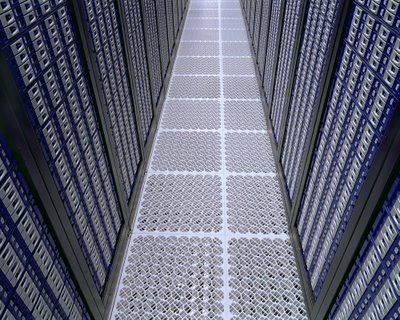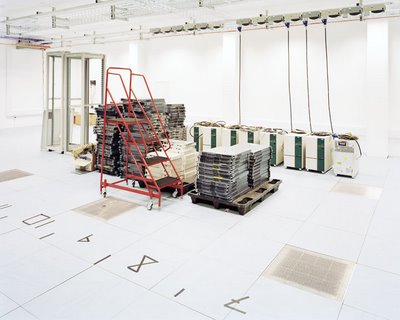 [Image: The supercomputer pictured above is the MareNostrum, "meaning 'our sea,'" New Scientist writes; "it is housed in a 1920s chapel at the Technical University of Catalonia in Barcelona, Spain, and built from commercially available parts." Photo by Simon Norfolk].
[Image: The supercomputer pictured above is the MareNostrum, "meaning 'our sea,'" New Scientist writes; "it is housed in a 1920s chapel at the Technical University of Catalonia in Barcelona, Spain, and built from commercially available parts." Photo by Simon Norfolk]."The supercomputers I'm showing here are powerful almost beyond human understanding," photographer Simon Norfolk explains, describing his extraordinary new images of supercomputers and their architectural settings. "They can map every molecule of the billions on a human DNA string; scrutinise at the atomic level the collision between two pieces of plutonium in an exploding bomb; or sketch the gravitational pull of every star in the galaxy upon every other star in the galaxy. These are not questions that humans could grapple with given plenty of time, a notebook and a sharp pencil."
Norfolk has also photographed computers used for "mapping and predicting global virus outbreaks" and for "simulating automotive crash tests."
 [Image: "Modeling physics inside an exploding nuclear warhead." Simon Norfolk].
[Image: "Modeling physics inside an exploding nuclear warhead." Simon Norfolk].These computers, Norfolk continues, "are omniscient and omnipresent and these are not qualities in which we find a simulacrum of ourselves – these are qualities that describe the Divine. The problem is not that these computers might one day resemble humans; it is that they already resemble gods."


 [Images: Simon Norfolk. The top image is titled "Mapping the human genome." The others are the TERA-1 and the TERA-10].
[Images: Simon Norfolk. The top image is titled "Mapping the human genome." The others are the TERA-1 and the TERA-10].In almost supernaturally sterile rooms, these angelic landscapes of silicon quietly hum their way through introspective worlds of calculation: derivatives, logorithms, advanced topologies. One could, in fact, imagine a whole new series of Duino Elegies, written by a posthumous Rainer Maria Rilke, in terrified praise of these cloistered machines – machines Rilke seems to describe preemptively in his "Seventh Elegy," where the "annihilator" meets the "Angel."
Rilke writes that "the external shrinks into less and less":
- Where once an enduring house was,
now a cerebral structure crosses our path, completely
belonging to the realm of concepts, as though it still stood in the brain.
Our age has built itself vast reservoirs of power,
formless as the straining energy that it wrests from the earth.
Temples are no longer known.
In any case, because all harddrives are actually geological objects – careful rearrangements of minerals under the influence of manmade magnetic fields – then these are mathematical terrains in the most exciting sense: the surface of the earth dreaming of spherical velocities inside otherwise undetectable stellar detonations.

 [Images: Two close-ups of cerebral machines. Simon Norfolk].
[Images: Two close-ups of cerebral machines. Simon Norfolk]. Finally, Giordano Bruno, following Giulio Camillo, wrote extensively about the idea of a Memory Palace, or Memory Theater. As Victoria Nelson tells us, the basic idea was that an "esoterically trained memory was a godlike vessel for encapsulating the entire universe within a single human mind." This was part of what Nelson calls a Neoplatonic "quasi-religion" that "venerated memory as an organ possessing magical and world-ordering powers." Neoplatonists believed that "the whole cosmos could be 'memorized' in a much more overt imitatio dei and by this act magically incorporated into the human organism" – or, of course, into the air-cooled circuits of a supercomputer.
So if I were forced to take issue with the existence of these machines, it would not be because of their use in modeling new nuclear warheads – as Norfolk makes clear they do – but in something far more secondary, even faintly absurd: what I'd call the lack of a supercomputer poetics, or a more imaginative role for these machines to play in our literary and even religious lives. Oracular, Delphic, radically non-secular: they are either all or none of the above.
(With sincere thanks to Simon Norfolk, who supplied all the images that appear in this post. And don't miss BLDGBLOG's later interview with Simon Norfolk, in which he discusses his war photography in much greater detail).
No comments:
Post a Comment